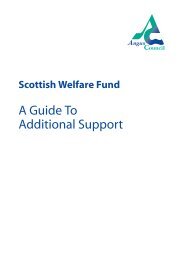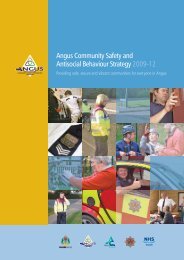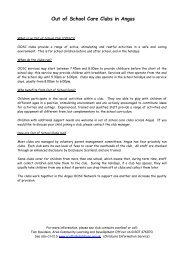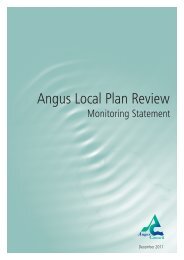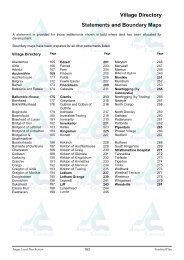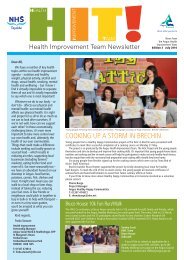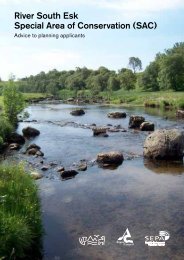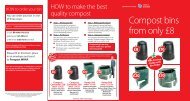Food Hygiene Information Scheme - Angus Council
Food Hygiene Information Scheme - Angus Council
Food Hygiene Information Scheme - Angus Council
You also want an ePaper? Increase the reach of your titles
YUMPU automatically turns print PDFs into web optimized ePapers that Google loves.
Guidance on the operation of the<strong>Food</strong> <strong>Hygiene</strong> <strong>Information</strong> <strong>Scheme</strong>February 2010The <strong>Food</strong> <strong>Hygiene</strong> <strong>Information</strong> <strong>Scheme</strong> (FHIS) is intended to besimple for consumers and businesses to understandand for Local Authorities to apply.
What is the <strong>Food</strong> <strong>Hygiene</strong> <strong>Information</strong> <strong>Scheme</strong>?The <strong>Food</strong> <strong>Hygiene</strong> <strong>Information</strong> <strong>Scheme</strong> is designed to provide consumers withinformation about hygiene standards at food premises and is being rolled out acrossScotland. Each business is given a rating to reflect the standards found at the time ofits statutory food hygiene inspection. This type of scheme is intended to allowconsumers to clearly differentiate between businesses that meet legal requirements 1and those that have failed to meet these requirements.The <strong>Food</strong> <strong>Hygiene</strong> <strong>Information</strong> <strong>Scheme</strong> is voluntary for local authorities to operate andfor businesses to display their ‘Inspection Outcome’ on the door of their establishment;however the web display is not voluntary.How long has the <strong>Food</strong> <strong>Hygiene</strong> <strong>Information</strong> <strong>Scheme</strong> been running?The demand for such a scheme was first recognised in Scotland by Consumer FocusScotland 2 in its paper '<strong>Food</strong> Law Enforcement – A Study of the Views of EnvironmentalHealth and <strong>Food</strong> Safety Officers in Scotland’ (February 2004) as an importantmechanism for informing consumer choice.The <strong>Food</strong> <strong>Hygiene</strong> <strong>Information</strong> <strong>Scheme</strong> (FHIS) was established in 2006 as a pilotScores on the Doors 3 project in Scotland in partnership with five volunteer LocalAuthorities. The project was overseen by a Steering Group that incorporatedconsumer, industry and enforcement representation. The pilot ran from November 2006to November 2008.In December 2008 the <strong>Food</strong> Standards Agency Board recommended continuation of the<strong>Food</strong> <strong>Hygiene</strong> <strong>Information</strong> <strong>Scheme</strong> as the appropriate format for a scheme for Scotland.This recommendation acknowledged the prevailing views of stakeholders in Scotlandreceived during the public consultation process.Who inspects food premises?Local authorities are responsible for enforcing food hygiene laws. To do this,enforcement officers from Environmental Health inspect food premises to ensure theyare meeting legal requirements. Essentially, inspection frequency is determined by thenature, compliance performance and risk that the business poses to public health.There are two outcomes of food hygiene inspections under the <strong>Food</strong> <strong>Hygiene</strong><strong>Information</strong> scheme, ‘Pass’ or ‘Improvement Required’ (failure to achieve a Pass).1 These requirements are established at European Community level and are given effect in the UK by the <strong>Food</strong><strong>Hygiene</strong> (Scotland) Regulations 2006 and separate but parallel legislation in England, Wales and Northern Ireland.2 Formerly the Scottish Consumer <strong>Council</strong>3 Scores on the Doors is the common name given to schemes whereby each food outlet is given ahygiene rating or hygiene score that reflects the inspection findings and may display this in their premiseswhere consumers can see it. Scores are also available via websites where consumers can see the scoresfor all the businesses in the local areaFHIS Guidance February 2010 2
It should be noted that the certificate awarded to the food business equates solely to thestandards found at time of the assessment but offers the best available information fromlocal authorities.A 'Pass' certificate should provide reassurance that the establishment meets legalrequirements at the time of inspection and looks like this.Any establishment falling below the required standard for a ‘Pass’ at the time ofinspection is classified as 'Improvement Required' and the certificate looks like this.It is recognised that an ‘Improvement Required’ certificate is unlikely to be displayed bythe food business.Establishments that have registered under hygiene legislation but have not yet beeninspected by their local authority enforcement officer are entitled to an 'AwaitingFHIS Guidance February 2010 3
Inspection' certificate. Once inspected the establishment will be awarded either a ‘Pass’or ‘Improvement Required’ certificate. An ‘Awaiting Inspection’ certificate looks like this.What is the scope of the <strong>Food</strong> <strong>Hygiene</strong> <strong>Information</strong> <strong>Scheme</strong>?The <strong>Food</strong> <strong>Hygiene</strong> <strong>Information</strong> <strong>Scheme</strong> is designed to provide hygiene information in allcircumstances where consumers make a choice about the food they purchase orconsume. Operations that could be considered to be outside the scope of the schemeare therefore restricted to wholesale and other inter-business supply.However, there are some operations that are registered as food businesses but whichwould not normally be considered by consumers to be food businesses. Visitor centresselling tins of biscuits amongst a range of other goods may be an example. In thesecircumstances the establishment may be exempt if both the food business operator andthe Local Authority agree that the operation should be exemptWhat has been put in place to ensure fairness to business?The <strong>Food</strong> <strong>Hygiene</strong> <strong>Information</strong> <strong>Scheme</strong> provides safeguards aimed at being fair to allbusinesses. These can be summarised as follows:a) The immediate remedy for all issues that result in an assessment of'Improvement Required' is in the hands of the business operating a foodestablishment and remedial action will not exceed the requirements of foodhygiene legislation.b) The Local Authority will revisit to reassess compliance within seven days of beingnotified by the business that all matters have been rectified.c) All relevant businesses within an area where the <strong>Food</strong> <strong>Hygiene</strong> <strong>Information</strong><strong>Scheme</strong> operates are entitled to a certificate.d) The right of appeal and review of decisions is a crucial safeguard but will beaccommodated within the existing Local Authority framework.FHIS Guidance February 2010 4
What is the remedy, if a business gets an ‘Improvement Required certificate?Since the 'Pass' standard is based on compliance at the time of assessment, theremedy for businesses assessed as ‘Improvement Required’ should always be in thehands of the food business operator. The local authority inspection report will givedetails of the short falls in reaching standards of legal compliance.What is the status of this guidance document?This guidance has been based on the best information available at the time of drafting.Revision or updated information will be issued as and when necessary.FHIS Guidance February 2010 5
How does the Eat safe Award fit in with the <strong>Food</strong> <strong>Hygiene</strong> <strong>Information</strong> <strong>Scheme</strong>?The <strong>Food</strong> <strong>Hygiene</strong> <strong>Information</strong> <strong>Scheme</strong> is entirely compatible with the Eat Safe Awardscheme. The two schemes although separate, have operated concurrently withoutdifficulty during the two-year <strong>Food</strong> <strong>Hygiene</strong> <strong>Information</strong> <strong>Scheme</strong> pilot.The <strong>Food</strong> <strong>Hygiene</strong> <strong>Information</strong> <strong>Scheme</strong> is designed to rate hygiene standards againstthe legal requirements and is distinct from the Eat Safe Award scheme, which isdesigned to recognise businesses that have achieved standards over and above thelegal requirements.The Eat Safe Award provides businesses operators who wish to demonstrate astandard of excellence over and above legal requirements with the ideal opportunity todo so.However, in keeping with the right of all businesses to a certificate in terms of the <strong>Food</strong><strong>Hygiene</strong> <strong>Information</strong> <strong>Scheme</strong>, the Eat Safe Award does not prevent a businessdisplaying both ‘Pass’ and an Eat Safe Award certificate should they wish oralternatively only an Eat Safe Award Certificate.An Eat Safe award certificate looks like this.FHIS Guidance February 2010 6




